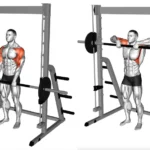Straight-Leg Dumbbell Deadlift: Exercise Overview
The straight-leg dumbbell deadlift is a powerful compound exercise designed to strengthen the hamstrings, glutes, and lower back, with a focus on the posterior chain. By emphasizing the hip hinge movement, this exercise enhances lower-body strength, improves flexibility, and promotes better posture and mobility. This movement supports athletic performance, core stability, and functional fitness, making it an excellent choice for those aiming to build a resilient lower body. It’s ideal for lower-body workouts, posterior chain-focused sessions, or full-body routines, offering benefits for both aesthetic and performance goals (Escamilla et al., 2002; Schoenfeld, 2010).
How to Perform the Straight-Leg Dumbbell Deadlift
- Stand with feet hip-width apart, holding a dumbbell in each hand with a neutral grip (palms facing your body), letting the weights hang in front of your thighs.
- Engage your core, keep your chest lifted, and retract your shoulder blades to maintain a neutral spine—this is your starting position.
- Hinge at your hips, pushing them back while keeping a slight bend in your knees, and lower the dumbbells along the front of your legs.
- Continue lowering until you feel a stretch in your hamstrings, typically when the dumbbells reach mid-shin level or slightly below, depending on your flexibility.
- Reverse the movement by driving your hips forward, returning to the upright position while keeping your back straight and the dumbbells close to your legs.
- Repeat for the desired number of repetitions, prioritizing controlled form.
Tips for Optimal Performance
- Maintain a Neutral Spine: Keep your back straight and avoid rounding your lower back to protect your spine and maximize hamstring engagement (McGill, 2010).
- Focus on Hip Hinging: Push your hips back rather than squatting down to target the hamstrings and glutes effectively, keeping knee bend minimal (Escamilla et al., 2002).
- Keep Dumbbells Close: Lower the weights along your legs to maintain control and reduce strain on your lower back.
- Control the Movement: Perform both the descent and ascent slowly to increase time under tension, enhancing muscle activation and growth (Schoenfeld, 2016).
- Breathe Properly: Inhale as you lower the dumbbells and exhale as you return to the starting position to support core stability and muscle oxygenation.
- Choose Appropriate Weight: Select dumbbells that allow you to maintain proper form for your target rep range (e.g., 8–12 reps for hypertrophy) to avoid compensatory movements.
Strengthening hamstrings with deadlifts? Explore their role in our Ultimate Guide to Muscle Groups for posterior chain power.







